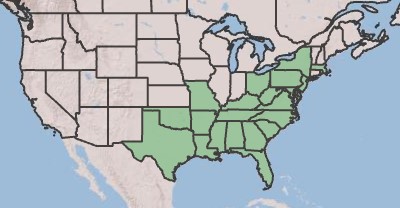Difference between revisions of "Chionanthus virginicus"
(→Ecology) |
(→Habitat) |
||
| (5 intermediate revisions by the same user not shown) | |||
| Line 28: | Line 28: | ||
==Ecology== | ==Ecology== | ||
===Habitat=== | ===Habitat=== | ||
| − | ''C. virginicus'' occurs in natural communities such as | + | ''C. virginicus'' occurs in natural communities such as mixed hardwood forests, pine flatwoods, and oak-magnolia-holly forests, often on wooded slopes and ravines. It grows in sandy and loamy sand soil and can tolerate xeric to mesic conditions. |
| − | ''C. virginicus has also been know to grow in open, disturbed areas such as along railroads, roadsides, and forest edges.<ref name = fsu> Florida State University Robert K. Godfrey Herbarium database. URL: http://herbarium.bio.fsu.edu. Last accessed: May 2023. Collectors: Loran C. Anderson, W. W. Baker, Richard Carter, R. Cherry, Bob Farley, Robert K. Godfrey, Ed Keppner, Lisa Keppner, Robert Kral, K. MacClendon, Robert T. MacClendon, Helen Roth, Annie Schmidt, and K. Willis. States and counties: Georgia: Camden. Florida: Bay, Calhoun, Franklin, Gadsden, Hamilton, Leon, Liberty, Orange, Wakulla, and Washington.</ref> | + | ''C. virginicus'' has also been know to grow in open, disturbed areas such as along railroads, roadsides, and forest edges.<ref name = fsu> Florida State University Robert K. Godfrey Herbarium database. URL: http://herbarium.bio.fsu.edu. Last accessed: May 2023. Collectors: Loran C. Anderson, W. W. Baker, Richard Carter, R. Cherry, Bob Farley, Robert K. Godfrey, Ed Keppner, Lisa Keppner, Robert Kral, K. MacClendon, Robert T. MacClendon, Helen Roth, Annie Schmidt, and K. Willis. States and counties: Georgia: Camden. Florida: Bay, Calhoun, Franklin, Gadsden, Hamilton, Leon, Liberty, Orange, Wakulla, and Washington.</ref> |
| − | Associated species of ''C. virginicus'' include, ''[[Pinus elliottii]]'', ''[[Pinus | + | Associated species of ''C. virginicus'' include, ''[[Pinus elliottii]]'', ''[[Pinus palustris]]'', ''[[Pinus taeda]]'', ''[[Acer rubrum]]'', ''Sabal palmetto'', ''[[Ilex cassine]]'', ''Berchemia scandens'', ''[[Magnolia virginiana]]'', ''Kalmia latifolia'',''[[Quercus laevis]]'', ''[[Quercus incana]]'', ''[[Quercus geminata]]'', ''[[Quercus hemisphaerica]]'', and ''[[Quercus nigra]]''.<ref name="fsu"/> |
<!--===Phenology===--> <!--Timing off flowering, fruiting, seed dispersal, and environmental triggers. Cite PanFlora website if appropriate: http://www.gilnelson.com/PanFlora/ --> | <!--===Phenology===--> <!--Timing off flowering, fruiting, seed dispersal, and environmental triggers. Cite PanFlora website if appropriate: http://www.gilnelson.com/PanFlora/ --> | ||
<!--===Seed dispersal===--> | <!--===Seed dispersal===--> | ||
Latest revision as of 13:31, 26 May 2023
| Chionanthus virginicus | |
|---|---|
| Scientific classification | |
| Kingdom: | Plantae |
| Division: | Magnoliophyta - Flowering plants |
| Class: | Magnoliopsida - Dicots |
| Order: | Scrophulariales |
| Family: | Oleaceae |
| Genus: | Chionanthus |
| Species: | C. virginicus |
| Binomial name | |
| Chionanthus virginicus L. | |

| |
| Natural range of Chionanthus virginicus from USDA NRCS Plants Database. | |
Common name: fringe-tree, white fringetree, old man's beard
Contents
Taxonomic Notes
Synonyms: none[1]
Varieties: none[1]
Description
Distribution
Ecology
Habitat
C. virginicus occurs in natural communities such as mixed hardwood forests, pine flatwoods, and oak-magnolia-holly forests, often on wooded slopes and ravines. It grows in sandy and loamy sand soil and can tolerate xeric to mesic conditions. C. virginicus has also been know to grow in open, disturbed areas such as along railroads, roadsides, and forest edges.[2]
Associated species of C. virginicus include, Pinus elliottii, Pinus palustris, Pinus taeda, Acer rubrum, Sabal palmetto, Ilex cassine, Berchemia scandens, Magnolia virginiana, Kalmia latifolia,Quercus laevis, Quercus incana, Quercus geminata, Quercus hemisphaerica, and Quercus nigra.[2]
Conservation, cultivation, and restoration
Cultural use
Photo Gallery
References and notes
- ↑ 1.0 1.1 Weakley, A.S. 2020. Flora of the Southeastern United States. Edition of 20 October 2020. University of North Carolina at Chapel Hill, Chapel Hill, North Carolina.
- ↑ 2.0 2.1 Florida State University Robert K. Godfrey Herbarium database. URL: http://herbarium.bio.fsu.edu. Last accessed: May 2023. Collectors: Loran C. Anderson, W. W. Baker, Richard Carter, R. Cherry, Bob Farley, Robert K. Godfrey, Ed Keppner, Lisa Keppner, Robert Kral, K. MacClendon, Robert T. MacClendon, Helen Roth, Annie Schmidt, and K. Willis. States and counties: Georgia: Camden. Florida: Bay, Calhoun, Franklin, Gadsden, Hamilton, Leon, Liberty, Orange, Wakulla, and Washington.